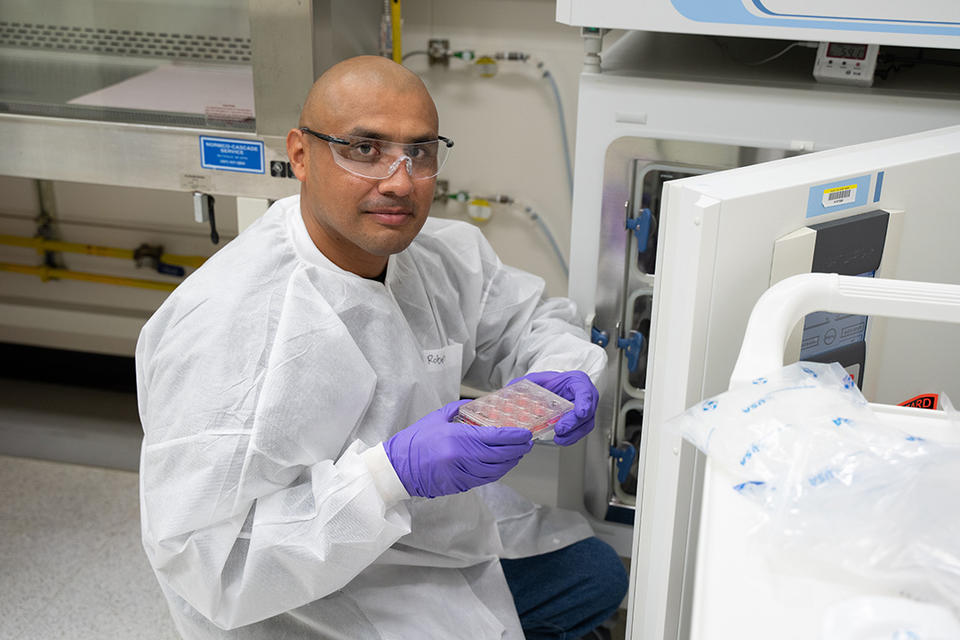
Sinking Our Teeth Into Science: How Biomedical Engineering Can Help Make Us Healthier

After experiencing a family member’s illness, NIST researcher Robert Gutierrez decided to pursue a research career in regenerative medicine.
Credit: M. King/NIST
Companies that make dental products — such as toothpaste, fillings and crowns — sometimes spend years developing these items, only to find out in final testing that they are too irritating to go in a human mouth.
But what if we could test dental products on a model of the human mouth tissue early in the development process?
We’re working toward making that a reality in my lab at NIST, and that knowledge may help unlock other scientific advances, too.
Representatives from health-focused government agencies and industry organizations asked us to look into how we could test these products earlier using 3D tissues from cells that behave just like the ones in the human mouth.
Once we purchased and received the tissues, we had 72 hours to work with them in their optimal condition before we’d have to worry about their quality affecting our results.
We made sure the tissues were heated to 37 degrees Celsius (98.6 Fahrenheit), similar to human body temperature. The tissues were also stored in incubators that kept them in similar conditions to that of the human mouth.
Credit: M. King/NIST
We tested necessary but sometimes irritating ingredients that are often found in dental products. We gathered a lot of data on several types of irritants that affect mouth tissue and also on the optimal way to test them.
Our results showed how a company can test an irritant early in its product testing, which may help companies in the overall product development process.
Becoming an Engineer
When I was younger, I tried lots of different jobs, like construction and working in fast food. I knew I wanted to go to college, but I would be the first in my family to do it. I also wasn’t sure what I wanted to study.
I was always observant and saw myself as possibly becoming an engineer. But engineering is a huge field, and I wasn’t sure what type of engineering would suit me best.
Around this time, my dad got sick. When he was hospitalized, it was scary for me to see my dad — a man who had never shown any weakness — suddenly become frail.
Around the same time, I was sitting in biology class at community college, and the professor was talking about how lizards can regenerate their tails. Obviously, humans can’t grow whole new body parts, but it got me wondering what types of things in medicine and biomedical engineering could possibly help my dad get better.
That got me interested in tissue engineering and regenerative medicine — the idea that you can help people by “regenerating” human tissues or cells.
I went on to do internships at Brown University and Duke University. I transferred to the University of California, Irvine, and began working in a lab there. Eventually, this led to me earning a Ph.D. from Brown University in biomedical engineering.
I wound up moving to Maryland because my daughter needed medical care here, and NIST was a natural fit for me.
It’s rewarding to work on biomedical research and see how the importance of quality medical care has impacted my family. I know the work I’m doing is helping to make people healthier.
From the Mouth to the Gut
While my team waits to present our work to the organizations that requested it, we will apply what we learned to a more ambitious project: measuring the movement of tiny plastics — known as microplastics and nanoplastics — through the human gut’s tissues.
We know tiny plastics are everywhere, including in our bodies. But scientists need to know more about the effect these plastics may have on our health.
So we are growing a replica of the human digestive tissue in our lab, and it’s a complex process.
Credit: M. King/NIST
Once we grow the model gut tissue, the goal is to create reproducible measurements of these small plastics as they move through the tissue — similar to how plastics currently move through our guts when we unknowingly eat or inhale them.
Creating reproducible methods that other researchers can use will help us better understand what’s happening when researchers get different results with their measurements. Currently, it’s hard to know if variances in measurements are because of the particles or because of the measurement approach. We hope to help standardize that so researchers can compare results more effectively.
While we focus on measurement challenges like this one at NIST, the larger scientific community may be able to use what we learn to learn more about tiny plastics and their impact on our health.
It’s exciting work, and as a researcher who is passionate about making people healthier, it keeps me engaged and motivated to keep finding the answers that will keep us all healthier.
Distribution channels: Technology
Legal Disclaimer:
EIN Presswire provides this news content "as is" without warranty of any kind. We do not accept any responsibility or liability for the accuracy, content, images, videos, licenses, completeness, legality, or reliability of the information contained in this article. If you have any complaints or copyright issues related to this article, kindly contact the author above.
Submit your press release